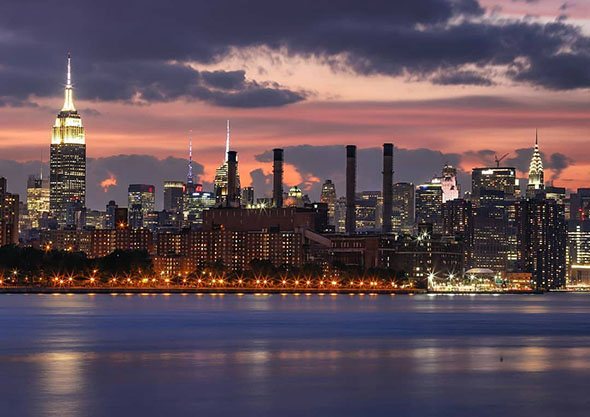8 must-see architecture destinations across the US

To be an architect, you must take all kinds of elements into consideration. Calculating measurements, evaluating costs of construction, selecting materials, and designing the space effectively for its future use all come into play.
Over the decades, domestic and international architects have constructed some of the most widely celebrated buildings to date on US soil. Being surrounded by award-winning buildings from coast to coast just might make you want to study architecture in the states.
Here are eight architecture destinations across the US that reveal why so many architects in the making earn their degree here.
- Empire State Building – New York City, NY
- Willis Tower – Chicago, Il
- Space Needle – Seattle, WA
- Gateway Arch – St Louis, MO
- Birmingham Civil Rights Museum – Birmingham, AL
- Ray and Maria Stata Center – Cambridge, MA
- Walt Disney Concert Hall – Los Angeles, CA
- The White House – Washington DC
Read on to learn more.
1. Empire State Building – New York City, New York
The Empire State Building is one of the most notable and recognizable buildings in New York City that’s been standing since 1931.
Designed by Shreve, Lamb and Harmon, the Empire State Building is a 102-story example of the 30’s Art-Deco period, which is best known for complex patterns outlined in gold on a black backdrop. The exterior’s series of vertical rectangular formations illustrate this style, especially at night. When lit up to glow in the night sky, its shapes display the gold-on-black designs that defined this period. For 40 years, the Empire State Building was the tallest building in the world.
Go to the top floor observatory to take in the iconic New York City view.
Nearby universities: Drew University, Hofstra University
2. Willis Tower – Chicago, Illinois
Nowadays, the Willis Tower is known for its transparent, glass deck where you can snap a photo with the maze of the cityscape behind you. The Willis Tower was designed by the Skidmore, Owings and Merril architecture firm. In the 70s, it became a part of Chicago’s competitive collection of downtown architecture. The Willis tower also was the world’s tallest building from 1973 to 1998.
Chicago’s entire downtown landscape is an architect’s playground. Much like the Parisian salons for legendary authors, Chicago cultivated a community of high-profile architects including Frank Lloyd Wright, Ludwig Mies and Louis Sullivan. Chicago’s buildings showcase decades of changing architectural styles combining different approaches to design and urban planning.
To get the full range of Chicago’s iconic architecture, take the architecture river cruise. You’ll glide through the city and get to see one landmark architecture masterpiece after another from both sides of Lake Michigan.
Nearby university: Illinois State University
3. Space Needle – Seattle, Washington
A fun fact about the Space Needle is that it had very humble beginnings. As stories go, the Space Needle’s designer, Edward E. Carlson, allegedly scribbled a drawing on a napkin inspired by a building he saw in Germany. This napkin art eventually evolved into formal sketches and many versions later became the sleek 605-foot structure we associate with Seattle.
The Space Needle opened up to millions during the 1962 World’s Fair. Since its 2017 renovation, you can now explore indoor and outdoor observation decks built of glass from the ground up. The Loupe is another exclusive upgrade that introduced rotating glass floors to the Space Needle and were the first of its kind in the world.
Nearby universities (by plane): Oregon State University
4. Gateway Arch – St. Louis, Missouri
You don’t see “parabola” used much outside your math textbooks. That being said, it is the only fitting word that describes the rounded-horseshoe shape of the Gateway Arch in St. Louis.
Built of stainless steel, this 630-foot monument has been standing tall since 1965. The Gateway Arch is meant to express how St. Louis has historically been referred to as, “The Gateway to the West”. Eero Saarinen, the gateway’s designer, meant for the arch to symbolize how St. Louis became the center of commerce for those heading west after the Louisiana Purchase in 1803. This was a land acquisition purchase where the US acquired 15 states that were formerly French territories.
Today, the arch is one of the most recognizable American monuments and you can ride a tram to the top for a unique 360° view of St. Louis.
Nearby university : Saint Louis University
5. Birmingham Civil Rights Museum – Birmingham, Alabama
Birmingham Civil Rights Institute demonstrates how an architect’s political and social drivers can tell stories beyond the blueprint. The BCRI is a museum commemorating the history of civil rights in Birmingham. J. Max Bond Jr., the BCRI’s designer, earned his bachelor’s and master’s during the civil rights era when African Americans accounted for less than one percent of those pursuing architecture degrees.
Later, he cofounded an architecture firm that designed the Martin Luther King Jr. Center for Nonviolent Social Change and on his own, he designed the Schomburg Center for Research in Black Culture. Through his work, we can see the investment in both finances and physical spaces reflecting the community’s commitment to acknowledging the past and moving forward.
Nearby university: The University of Alabama at Birmingham
6. Ray and Maria Stata Center – Cambridge, Massachusetts
The Ray and Maria Stata Center’s odd angles and shapes make it look like it came straight out of a Dr. Seuss book or a Picasso painting. Designed by Frank Gehry, who’s known as a global contemporary architecture icon, the Ray and Maria Strata Center lives on Building 20 of MIT’s campus.
Despite the cartoonish outside, the building is fit for purpose. The roof is strategically designed to collect rain and feed it back down to the surrounding greenery. It’s plain to see why the center’s mindful designs won sustainability and engineering excellence awards.
Nearby university: Suffolk University
7. Walt Disney Concert Hall – Los Angeles, CA
Whimsical waves of stainless steel make the Walt Disney Concert Hall hard to miss in downtown Los Angeles. The sculpted curves interact with each other to create a freeze frame of various sheet music books flipping pages. The imagery of sheet music is fitting as it is the home of the LA Philharmonic Orchestra.
The concert hall was completed in 2003 and designed by Frank Gehry. Acoustics and seating were all taken into consideration when designing both the interior and exterior of this venue. By day, the silver stainless steel reflects the sunlight for extra sheen. By night it takes on the hues of downtown LA’s glimmering city lights. It’s a clever, magical effect that is no doubt a nudge to its namesake inspiration.
8. The White House – Washington DC
You can’t talk about US architecture without mentioning the building that gets the most buzz: the White House. The original White House was designed by James Hoban in 1792. Despite being modeled after the Irish parliament building in Dublin, the front columns represent how the US political system borrowed from Ancient Greek and Roman democratic values.
While the White House has not changed much in recent years, past presidencies differ. Presidents Theodore Roosevelt, Howard Taft and Harry Truman updated the White House to add floors (hello West Wing) and expand the Oval Office, reconstructing the space as we know it today.
Nearby university: George Mason University
If you want to learn more about studying architecture in the US, please visit our website.
You may also like to read about Sun, city or scenery: where is your perfect US study destination?
To keep up to date with student life and learning in the UK, US and China, follow us on Facebook, Instagram and Twitter and YouTube!



